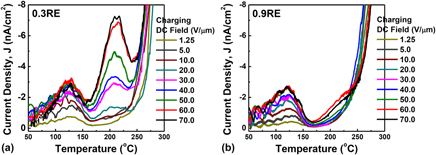Crossref Citations
This article has been cited by the following publications. This list is generated based on data provided by
Crossref.
Yoon, Seok-Hyun
2015.
Effect of Dy on the dielectric nonlinear behavior of Mn and V-doped BaTiO3multilayer ceramic capacitors.
Journal of Materials Research,
Vol. 30,
Issue. 16,
p.
2447.
Hong, Kootak
Lee, Tae Hyung
Suh, Jun Min
Yoon, Seok-Hyun
and
Jang, Ho Won
2019.
Perspectives and challenges in multilayer ceramic capacitors for next generation electronics.
Journal of Materials Chemistry C,
Vol. 7,
Issue. 32,
p.
9782.
Ryu, Gyung Hyun
Bowes, Preston C.
McGarrahan, John R.
Irving, Douglas L.
and
Dickey, Elizabeth C.
2022.
Fermi level pinning in Co‐doped BaTiO3: Part I. DC and AC electrical conductivities and degradation behavior.
Journal of the American Ceramic Society,
Vol. 105,
Issue. 1,
p.
292.
Jiang, Kunlun
Zhang, Lei
Li, Bo
Li, Peng
Yu, Shuhui
Sun, Rong
Fu, Zhenxiao
and
Cao, Xiuhua
2022.
Importance of uniformity of grain size to reduce dc degradation and improve reliability of ultra-thin BaTiO3-based MLCCs.
Ceramics International,
Vol. 48,
Issue. 20,
p.
30020.
Choi, Jeoung Sik
Kim, Dong Chul
Shin, Hyo Soon
Kim, Hyungsuk K. D.
Yeo, Dong Hun
and
Lee, Joon Hyung
2023.
Effect of Mn Substitution on the Dielectric Constant and Breakdown Voltage of Anti-ferroelectric PLZT.
Journal of Electronic Materials,
Vol. 52,
Issue. 10,
p.
6530.
Choi, Jeoung Sik
Kim, Dong Chul
Shin, Hyo Soon
Yeo, Dong Hun
and
Lee, Joon Hyung
2023.
Effect of substitution of Dy3+ on dielectric constant and reliability of anti-ferroelectric PLZT.
MRS Communications,
Vol. 13,
Issue. 6,
p.
1260.
Seo, Intae
Lee, Ka-Young
Oh, Cheol-Min
and
Kang, Hyoung-Won
2023.
Research Trends on the Influence of Oxygen Vacancies in Post BaTiO3 (BT) Ceramics for Next-Generation MLCCs.
Ceramist,
Vol. 26,
Issue. 2,
p.
172.
Song, Hyunseok
Goud, J. Pundareekam
Ye, Jiwon
Jung, Wonsik
Ji, Jaehoon
and
Ryu, Jungho
2023.
Review of the thermally stimulated depolarization current (TSDC) technique for characterizing dielectric materials.
Journal of the Korean Ceramic Society,
Vol. 60,
Issue. 5,
p.
747.
Huang, Xiong
Zhang, Lei
Wang, Pengfei
Jian, Gang
Yang, Jun
Li, Bo
Yu, Shuhui
Sun, Rong
Fu, Zhenxiao
and
Cao, Xiuhua
2023.
Excellent permittivity-temperature stability and reliability performance of ultra-thin Ba0.97Ca0.03TiO3-based MLCCs.
Journal of Asian Ceramic Societies,
Vol. 11,
Issue. 1,
p.
146.
Choi, Jeoung Sik
Kim, Dong Chul
Shin, Hyo Soon
Yeo, Dong Hun
and
Lee, Joon Hyung
2024.
Effect of oxygen vacancies on dielectric property and reliability of anti-ferroelectric PLZT applicable to EV-MLCC.
Bulletin of Materials Science,
Vol. 47,
Issue. 1,
Lv, Yetong
Wang, Pengfei
Qin, Yexia
Zhao, Jianwei
Yang, Jun
Fu, Zhenxiao
Cao, Xiuhua
Zhang, Lei
Yu, Shuhui
and
Sun, Rong
2024.
Significantly enhanced reliability in defect-engineered BaTi1-Mg O3 ceramics.
Ceramics International,
Vol. 50,
Issue. 19,
p.
37002.
Tan, Junhui
Cheng, Lixia
Wang, Pengfei
Huang, Rongxia
Fu, Zhenxiao
Cao, Xiuhua
Zhang, Lei
Yu, Shuhui
and
Sun, Rong
2024.
Significantly Enhanced Insulation Resistance Degradation of BaTiO3-Based MLCCs with High Temperature Stability via Defect Engineering.
p.
1.
Tan, Junhui
Wang, Pengfei
Huang, Rongxia
Lin, Hua-Tay
Hu, Zhiping
Yang, Jun
Cheng, Lixia
Fu, Zhenxiao
Cao, Xiuhua
Zhang, Lei
Yu, Shuhui
and
Sun, Rong
2024.
Stability and reliability of BaTiO3-based MLCCs with high dielectric by rare-earth doping: an insight from domain-engineering.
Applied Physics A,
Vol. 130,
Issue. 8,
Cheng, Xu
Zhen, YiChao
Xiao, Mengjian
Zhao, Peiyao
Hui, Kezhen
Zhang, Weichen
Jiang, Ying
Guo, Limin
Fu, Zhenxiao
Cao, Xiuhua
Wang, Hong
and
Wang, Xiaohui
2025.
Diffusion and defect chemistry of temperature-stable BaTiO3-based ceramics: Experiment and theoretical calculations.
Journal of the European Ceramic Society,
Vol. 45,
Issue. 1,
p.
116825.

 ${\rm{Mn}}_{{\rm{Ti}}}^{\prime \prime } {\rm{ - V}}_{\rm{O}}^{\cdot\cdot}$ or
${\rm{Mn}}_{{\rm{Ti}}}^{\prime \prime } {\rm{ - V}}_{\rm{O}}^{\cdot\cdot}$ or  ${\rm{Mn}}_{{\rm{Ti}}}^\prime {\rm{ - V}}_{\rm{O}}^{\cdot\cdot}$, which was observed in low Dy-concentration specimens. These results experimentally demonstrate that the rare earth element, Dy, decreases the concentration of the defect dipoles and thereby controls dielectric aging.
${\rm{Mn}}_{{\rm{Ti}}}^\prime {\rm{ - V}}_{\rm{O}}^{\cdot\cdot}$, which was observed in low Dy-concentration specimens. These results experimentally demonstrate that the rare earth element, Dy, decreases the concentration of the defect dipoles and thereby controls dielectric aging.